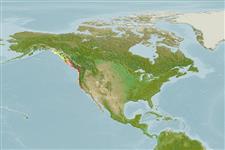Classification / Names
Common names from other countries
Main reference
Size / Weight / Age
Max length : 270 cm TL male/unsexed; (Ref. 96339); common length : 130 cm TL male/unsexed; (Ref. 12193); max. published weight: 159.0 kg (Ref. 2850); max. reported age: 60 years (Ref. 72476)
Length at first maturity
Lm 100.0, range 100 - ? cm
Environment
Marine; freshwater; brackish; demersal; anadromous (Ref. 51243); depth range 0 - 80 m (Ref. 50610)
Climate / Range
Temperate; 10°C - 20°C (Ref. 2059), preferred 6°C (Ref. 107945); 65°N - 32°N, 166°W - 114°W (Ref. 54261)
Distribution
North America: Aleutian Islands and the Gulf of Alaska to Ensenada, Mexico. Considered vulnerable in Canada. The Asian population is now considered to be a separate species Acipenser mikadoi (Ref. 6866). International trade restricted (CITES II, since 1.4.98; CMS Appendix II).
Countries | FAO areas | Ecosystems | Occurrences | Introductions
Short description
Dorsal
spines
(total): 0;
Dorsal
soft rays
(total): 33-35;
Anal
spines: 0;
Anal
soft rays: 22 - 28. Characterized by a single row of 1 to 4 bony plates along the midventral line between the anus and the anal fin, and about 33 to 35 rays in the dorsal fin. Dorsal arises at posterior third of the total length; anal fin arises under posterior part of dorsal; pectorals originate low on the body just behind gill opening and are large and rounded; pelvic fins arise near the anus. Generally olive to dark green, lower parts more or less whitish green; a longitudinal olive-green stripe on side between lateral and ventrolateral plates, another on midventral surface; fins grayish to pale green (Ref. 27547). Barbels usually situated closer to mouth than to snout tip; coloration of scutes along side paler than skin (Ref. 86798).
IUCN Red List Status (Ref. 115185)
Threat to humans
Harmless
Human uses
Fisheries: minor commercial; gamefish: yes
More information
ReferencesAquacultureAquaculture profileStrainsGeneticsAllele frequenciesHeritabilityDiseasesProcessingMass conversion
Tools
Special reports
Download XML
Internet sources
Estimates of some properties based on models
Phylogenetic diversity index
PD50 = 0.5000 many relatives (e.g. carps) 0.5 - 2.0 few relatives (e.g. lungfishes)
Trophic Level
3.5 ±0.52 se; Based on food items.
Resilience
Low, minimum population doubling time 4.5 - 14 years (K=0.05-0.09)
Vulnerability
Very high vulnerability (80 of 100)
Price category
